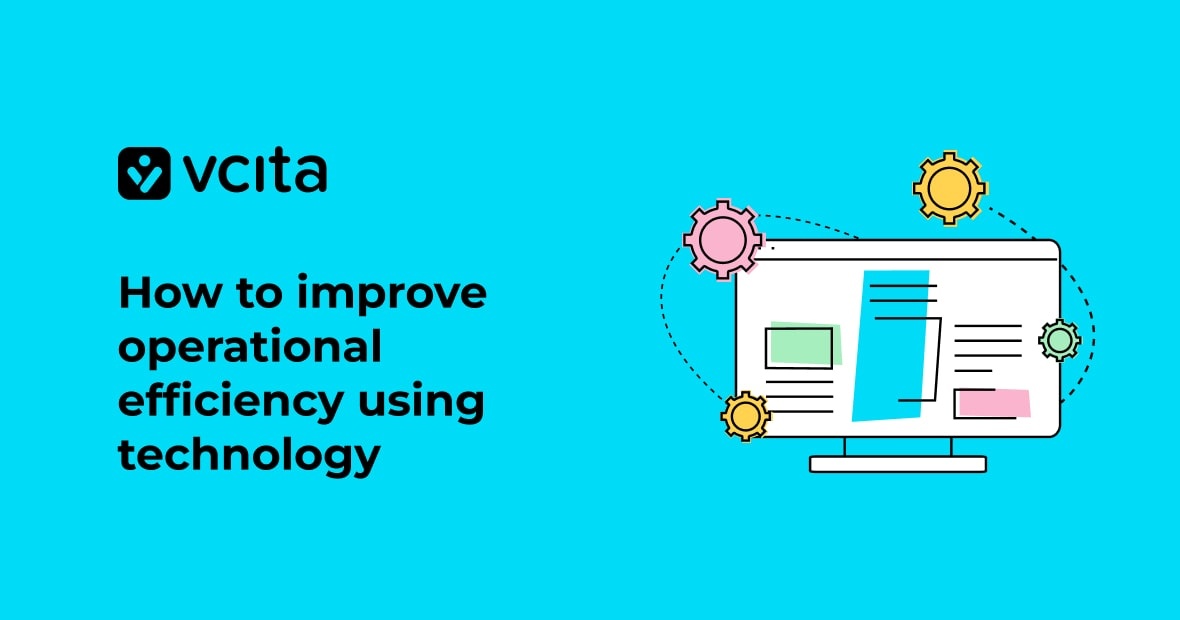Ready to take your company to the next level? Business Process Management (BPM) is your secret weapon. It might sound fancy, but it’s actually a simple methodology for boosting efficiency and crushing those business goals.
By mapping out your existing processes and leveraging smart BPM software, you’ll be continuously improving and seeing real results in no time. So, let’s dive into the world of BPM and discover how it can transform your small business from good to great.
What is business process management (BPM)?
Business Process Management (BPM) is a systematic approach to making your organization’s workflow more effective, efficient, and adaptable. It’s all about analyzing, designing, implementing, and continuously improving your business processes to achieve better outcomes.
The core principle of BPM
At its heart, BPM is about optimizing how work gets done in your small business. It’s not just about automation, though that’s often part of it. Instead, it’s a holistic approach that considers people, processes, and technology together.
Think of BPM as your business’s GPS. It helps you navigate from where you are to where you want to be, constantly recalculating to find the best route as conditions change.
Types of BPM
There are several flavors of BPM to suit different business needs:
- Human-centric BPM: Focuses on processes where people are the primary actors.
- Document-centric BPM: Revolves around the creation, routing, and approval of documents.
- Integration-centric BPM: Deals with the exchange of information between different systems.
The BPM lifecycle
BPM isn’t a one-and-done deal. It’s an ongoing cycle that typically includes these steps:
- Design: Map out your processes.
- Model: Test different scenarios.
- Execute: Put your processes into action.
- Monitor: Track performance.
- Optimize: Make improvements based on data.
By following this cycle, you’re constantly refining your processes for better efficiency and results.
BPM and your business strategy
Implementing BPM aligns closely with your overall business strategy. It helps you identify bottlenecks, reduce costs, and improve customer satisfaction. With the right BPM software, you can transform ad hoc processes into streamlined workflows, leading to improved efficiency and better business outcomes.
The benefits of implementing BPM in your small business
Implementing BPM in your small business can be a game-changer. Let’s explore the specific ways that this strategic approach can transform your operations and boost your success.
Streamlined operations and improved efficiency
By adopting BPM, you’ll be able to identify and eliminate bottlenecks in your existing processes. This leads to streamlined operations and increased efficiency across your entire organization. With BPM software, you can automate repetitive tasks, freeing up your team to focus on more value-adding activities. The result? A leaner, more productive business that can do more with less.
Enhanced customer satisfaction
BPM directly impacts your customers. By optimizing your processes, you’ll be able to deliver products or services faster and with higher quality. This translates to happier customers and increased loyalty. Plus, with improved efficiency, you’ll have more time to focus on customer needs and provide personalized experiences.
Data-driven decision making
One of the key advantages of BPM is the wealth of data it provides. By monitoring your process performance, you’ll gain valuable insights into your business operations. This data allows you to make informed decisions and continuously improve your processes. You’ll be able to identify trends, anticipate problems, and proactively address issues before they impact your business outcomes.
Adaptability and scalability
In today’s fast-paced business environment, adaptability is crucial. BPM provides the flexibility to quickly adjust your processes in response to market changes or new opportunities. Whether you need to scale up operations or pivot your business strategy, BPM tools make it easier to implement changes across your organization. This agility can give you a significant competitive advantage in your industry.
Types of business process management methodologies
Business Process Management (BPM) isn’t a one-size-fits-all solution. There are several methodologies you can choose from, depending on your small business’s needs and goals. Let’s explore some of the most common types of BPM to help you find the right fit for your organization.
Human-centric BPM
This approach puts people at the center of your business processes. It’s all about empowering your employees to make decisions and interact with customers more effectively. With human-centric BPM, you’re focusing on improving user interfaces and creating workflows that enhance the human experience. This method is great if you’re looking to boost employee satisfaction and customer service.
Document-centric BPM
If your business deals with a lot of paperwork, this might be your go-to methodology. Document-centric BPM streamlines how you create, process, and store documents. It’s perfect for industries like legal, finance, or healthcare where documentation is crucial. By implementing this approach, you can say goodbye to those pesky filing cabinets and hello to improved efficiency.
Integration-centric BPM
This methodology focuses on connecting different systems and applications within your business. It’s all about creating a seamless flow of information across your organization. If you’re dealing with multiple software tools that don’t play nice together, integration-centric BPM can help you create a more cohesive business strategy.
Ad hoc BPM
Sometimes, you need a more flexible approach. Ad hoc BPM allows you to create and modify processes on the fly. It’s perfect for businesses that deal with a lot of unique or unpredictable situations. This methodology empowers your team to adapt quickly to changing circumstances and continuously improve your processes.
Remember, the key to successful BPM is choosing the right methodology for your business needs. Whether you’re focusing on people, documents, integration, or flexibility, there’s a BPM approach that can help transform your small business and drive better business outcomes.
Steps for successful BPM implementation
Implementing BPM in your small business doesn’t have to be daunting. By following these steps, you’ll be on your way to improved efficiency and better business outcomes in no time.
Identify and map your processes
Start by taking a good, hard look at your existing processes. What’s working well? Where are the bottlenecks? Grab a whiteboard and map out each step of your key workflows. This visual representation will help you spot inefficiencies and opportunities for improvement.
Set clear goals
What are you hoping to achieve with BPM? Maybe you want to reduce costs, improve customer satisfaction, or boost productivity. Whatever your aims, make sure they align with your overall business strategy. Setting specific, measurable goals will help you track your progress and stay motivated.
Choose the right BPM tools
With so many business process management tools out there, it’s crucial to find one that fits your needs. Look for user-friendly interfaces and features that match your workflow. Whether you need document-centric BPM or a more human-centric approach, there’s a solution out there for you. vcita, for example, offers an all-in-one platform that can streamline various aspects of your small business operations.
Implement and train
Once you’ve chosen your BPM software, it’s time to put it into action. Start with a pilot project to work out any kinks. Then, make sure your team is on board and well-trained. Remember, successful BPM is as much about people as it is about technology.
Monitor and optimize
The beauty of BPM is that it’s not a one-and-done deal. Keep a close eye on your process performance and be ready to make adjustments. Use the analytics provided by your BPM software to identify areas for process improvement. By continuously improving your workflows, you’ll keep your business agile and competitive.
Choosing the right BPM tools
When it comes to transforming your small business through BPM, selecting the right tools is crucial. Let’s explore how to choose the best business process management software for your needs.
Assess your business strategy
Before diving into the world of BPM tools, take a step back and evaluate your overall business strategy. What are your key business outcomes? Are you looking to improve efficiency, automate workflows, or enhance process performance? Understanding your goals will help you narrow down the options and find a tool that aligns with your vision.
Consider different types of BPM
Not all BPM tools are created equal. Some focus on human-centric BPM, emphasizing user interfaces and collaboration. Others specialize in document-centric BPM, streamlining paperwork and approvals. There’s also business process automation software that can handle repetitive tasks with minimal human intervention. Choose a tool that matches your specific process improvement needs.
Evaluate features and functionality
Look for BPM software that offers:
- Intuitive workflow management
- Process modeling capabilities
- Performance analytics
- Integration with existing processes
Remember, the goal is to find a tool that’s powerful enough to handle your needs but user-friendly enough for your team to adopt easily.
Think long-term
The best BPM tools support the entire BPM lifecycle, from process design to execution and monitoring. They should also facilitate continuous improvement, allowing you to refine your processes over time. Consider how the tool will grow with your business and adapt to changing needs.
Test drive before committing
Many BPM software providers offer free trials or demos. Take advantage of these opportunities to test the user interface, explore features, and see how the tool handles your specific use cases. This hands-on experience can be invaluable in making the right choice for your small business.
Continuously improving your business processes
In today’s fast-paced business environment, flexibility is key. Your business processes shouldn’t be set in stone; they need to evolve with your company’s growth and changing market demands. Let’s explore how you can keep your BPM strategy agile and responsive.
Embrace a human-centric approach
When adapting your processes, always keep your team and customers at the forefront. Human-centric BPM focuses on creating user-friendly interfaces and workflows that enhance the experience for everyone involved. This approach not only improves efficiency but also boosts employee satisfaction and customer loyalty.
Keep up with the BPM lifecycle
BPM isn’t a one-and-done deal. It’s an ongoing journey of refinement and optimization. The steps of the BPM lifecycle – design, model, execute, monitor, and optimize – form a continuous loop that keeps your business processes evolving. By embracing this cycle, you’re setting your small business up for long-term success and improved efficiency.
Foster a culture of continuous improvement
Remember, BPM isn’t just about software and flowcharts – it’s about people too. Encourage your team to be on the lookout for ways to enhance existing processes. Create an environment where employees feel comfortable suggesting improvements, no matter how small. Sometimes, the most impactful changes come from those working on the front lines. By fostering this mindset, you’re not just improving efficiency; you’re building a more engaged and innovative workforce.
Align BPM with business strategy
As you continuously refine your processes, always keep your broader business strategy in mind. Each improvement should contribute to your overall business outcomes. Whether it’s streamlining customer service, optimizing inventory management, or enhancing product development, make sure your process improvements are moving you closer to your strategic goals. This alignment ensures that your BPM efforts are not just making processes smoother, but are actively driving your business forward.
Leverage BPM software for ongoing improvement
Investing in robust business process management software can be a game-changer for your small business. These tools offer:
- Real-time process performance monitoring
- Automated workflow management
- Easy-to-use process modeling features
With the right BPM software, you can quickly identify bottlenecks, streamline operations, and adapt to new challenges on the fly.
Remember, the goal is to create a dynamic system that can handle both structured workflows and ad hoc processes. With the right approach to BPM, you’ll build a more resilient, efficient, and competitive small business that’s ready to tackle whatever challenges come your way.
BPM can be a gamechanger for your small business
By now, you can see how business process management can truly transform your small business. Remember, BPM is about more than just technology. It’s a way of thinking that can revolutionize how your small business operates, setting you up for sustainable growth and success. By leveraging BPM, you’re not just improving individual processes – you’re transforming your entire approach to business management. The result is a more efficient, customer-focused, and adaptable organization ready to thrive in today’s competitive landscape.




























